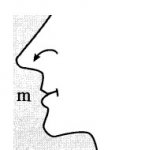标准美语发音的13个秘诀 CD 4 Track 49
时间:2018-12-26 作者:英语课 分类:标准美语发音的13个秘诀 CD4
Chapter 12. Nasal Consonants 1 CD 4 Track 49
We now turn to the three consonants whose sound comes out through the nose—M, N, and the NG combination. They each have one thing in common, their sound is blocked in the mouth in one of three locations. Two of them, N and NG, you can't even see, as with R, so they're hard to pick up on.
[m] is the easiest and most obvious. Like [b], the lips come together, the air can't get out, so it has to come out through the nose.
[n] is in a position similar to [t],but it can't be at all tense. It has to be completely relaxed, filling the whole mouth, touching 2 the insides of all the teeth, leaving no room for the air to escape, except by the nose.
[ng] is back in the throat with[g]. The back of the tongue presses back, and again, the air comes out through the nose.
- Consonants are frequently assimilated to neighboring consonants. 辅音往往被其邻近的辅音同化。 来自《简明英汉词典》
- Vowels possess greater sonority than consonants. 元音比辅音响亮。 来自《现代英汉综合大词典》


